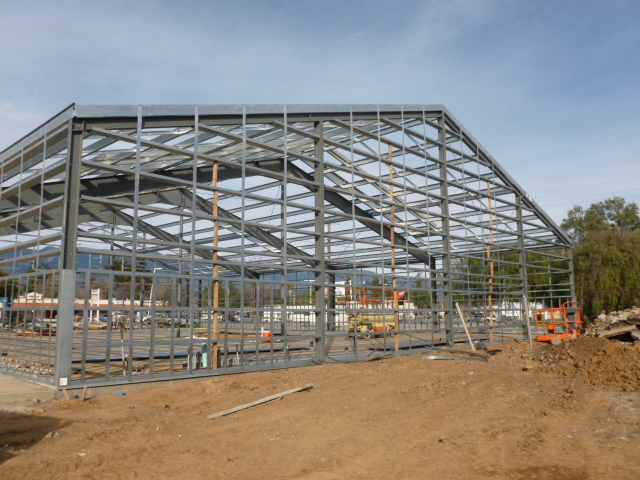Prefabricated metal buildings have been around for decades. They are a unique combination of durability and architectural finishes. Today's generation of metal buildings are structurally the same as previous generations; however, the architectural options and the aesthetics have greatly expanded. As energy efficiency and "green" building solutions become more important, steel buildings are becoming a more sensible solution.
Pre fabricated metal buildings, also known as building systems, steel buildings, and pre-engineered metal buildings (PEMB) are all engineered, designed and fabricated in a controlled manufacturing environment and then shipped to the job site for assembly or erection.
Identifying a prefabricated metal building company is important, but it is equally as important to identify an organization who will insure it's accurate fabrication, delivery and erection.
PEMB's include all structural fames, secondary structural, bracing, roof and wall sheeting, along with trims and accessories are selected to make a complete structure or building shell.

A quick count of manufacturers on recent Internet searches turned up more than 100 choices. Many are small local and regional fabricators. In an effort to identify those that work to an industry standard, it is logical to refer to an industry association. An association that maintains a set of quality control standards, engineering practices, manufacturing and support of their products will help narrow down the choices. The Metal Building Manufacturing Association (MBMA) is the association for the pre-engineered metal building industry.
The MBMA is the 43 manufacturer in the association. Of these 43, 24 are single plant manufacturers, many in the South and the Southeast. The NCI group of companies has 10 brand names in their stable, Nucor has 5 brands and BlueScope carries 4 brands.
Like Kleenex is to tissues, names like Quonset huts, General Steel, Butler Buildings, Varco Purden, Metallic Buildings, Star Building Systems, American Building Company are all manufacturers of pre fabricated metal buildings.
Buying a pre fabricated metal building is not a simple process. It is important to identify a building's purpose or function, which then translates into the size and geometry of the building. The building location both geographically and on a specific site will have an impact on its design. Simply in some regions, buildings are designed to keep the cold out and the heat in and in other areas it is just the opposite. Local and nation building codes is the next layer of integration in the over all building design. Additionally, many regions have zoning and planning ordinances which will also need to be assessed as the exterior design is developed. Having a metal building contractor or a Design Build contractor working with you on this key phase of a project can give you confidence all these issues are being addressed.
About 40 years ago, the requirements were a lot simpler, keep the rain and the wind out and make it lockable.
Today there are millions of square foot distribution centers, as well as are aerospace hangars, 120 feet tall, spanning over 400 feet wide with really large doors. There are manufacturing environments with 100-ton overhead cranes rolling along the frame lines, along with freezer warehouses utilizing insulated steel wall and roof panels to maximize energy efficiency. There are beautiful equestrian riding arena and huge bulk material storage buildings. Hollywood also uses them for sound studios. Sports teams play in them, Parishioners worship in them, manufacturers build everything from A-Z in them. Farmers store their crops in them. Solar energy companies use the roofs for energy renewal. Wineries love them for there functional spaces in unique architectural flexibility.
Prefabricated metal buildings are utilized in all parts of our economy, especially government, military, utilities, transportation, aerospace, airlines, commercial buildings, multistory offices, industrial, distribution, warehousing agricultural, sports complexes and churches.
Pre-engineered metal buildings bring value to a building project. Interpreting the building needs and translating them into a metal building solution, is best done with a Design Build contractor who is understands this system building approach. The Design Build Contractor knows the material options and is capable of erecting the building safely and securely, keeping attention to detail.
Meeting the owner's expectations for a building project is critical. Taking the time to identify the right solutions with the right team will give peace of mind in the early stages of a project. The process of design development and budgeting, through engineering, permitting, construction and finally occupancy should be one of teamwork and coordinated efforts, not a series of crisis's leaving it participants exhausted and worn out at the end of the project.
In considering a project, find a contractor who has a track record, references and the experience needed to be a part of your project team. Price is always important, and so are value, quality and support during and after the project. Ask which PEMB manufacturer they work with and why. Talk to a contractor's references. Any building project is both a process and an end product. Does this contractor have the reputation, experience and approach for your project that addresses your needs?
Located in Anaheim, California, Facility Builders & Erectors, Inc. regularly works with Owners, Architects and other Contractors delivering Design-Build projects with pre-engineered buildings only or entire facilities.
Published on August 20, 2013 | Comments: 0
Leave a comment